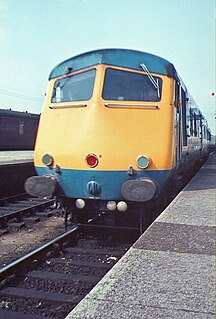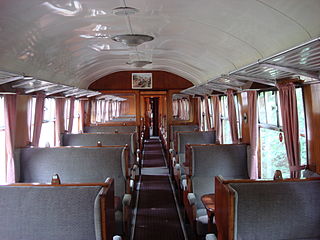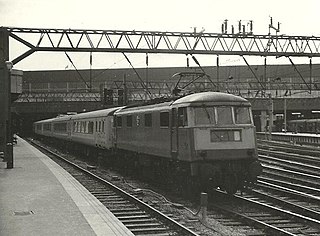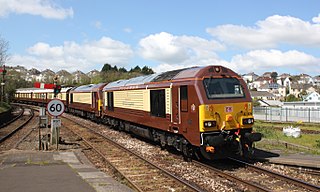
The InterCity 125 is a diesel-powered passenger train built by British Rail Engineering Limited between 1975 and 1982. Each set is made up of two Class 43 power cars, one at each end, and a rake of Mark 3 carriages. The name is derived from its top operational speed of 125 mph (201 km/h). Initially the sets were classified as Classes 253 and 254.

Metro-Cammell, formally the Metropolitan Cammell Carriage and Wagon Company (MCCW), was an English manufacturer of railway carriages, locomotives and railway wagons, based in Saltley, and subsequently Washwood Heath, in Birmingham. Purchased by GEC Alsthom in May 1989, the factory was closed in 2005.

InterCity was introduced by British Rail in 1966 as a brand-name for its long-haul express passenger services.

The Blue Pullmans were luxury trains used from 1960 to 1973 by British Rail. They were the first Pullman diesel-electric multiple units, incorporating several novel features.

British Rail was the brand image of the nationalised railway owner and operator in Great Britain, the British Railways Board, used from 1965 until its breakup and sell-off from 1993 onwards.

British Railways Mark 1 is the family designation for the first standardised designs of railway carriages built by British Railways (BR) from 1951 until 1974, now used only for charter services on the main lines or on preserved railways.

The Mark 2 family of railway carriages are British Rail's second design of carriages. They were built by British Rail workshops between 1964 and 1975. They were of steel construction.

The British Rail Mark 3 is a type of passenger carriage developed in response to growing competition from airlines and the car in the 1970s. A variant of the Mark 3 became the rolling stock for the High Speed Train (HST).
The Southern Railway (SR) gave the designations 6 PUL, 6 CITY and 6 PAN to electric multiple units built to work the routes between London and Brighton, West Worthing and Eastbourne. None of these units survived long enough in British Rail ownership to be allocated a TOPS class number. The 6 PUL units were designated 6 COR until 1935.
A wide variety of hauled coaches have been used on the railways of Ireland. This page lists all those since 1945.
Push–pull is a configuration for locomotive-hauled trains, allowing them to be driven from either end of the train, whether having a locomotive at each end or not.

The British Rail Class 501 electric multiple units were built in 1955/56 for use on the former LNWR/LMS suburban electric network of the London Midland Region. A total of 57 three-car units were built.

Caledonian Sleeper is the collective name for overnight sleeper train services between London and Scotland, in the United Kingdom. It is one of only two currently operating sleeper services on the railway in the United Kingdom, the other being the Night Riviera which runs between London and Penzance.

The Belmond Royal Scotsman is a Scottish overnight luxury train, started in 1985 by GS&WR, and run since 2005 by Belmond Ltd. Its itineraries include 2, 3, 4, 5 or 7 night journeys around the Scottish Highlands, visiting castles, distilleries and historic sites. Once each year, it also makes a 7 night journey around the whole of Great Britain.
The Night Ferry was an international boat train from London Victoria to Paris Gare du Nord that crossed the English Channel on a train ferry. It ran from 1936 until 1939 when it ceased due to the onset of World War II. It resumed in 1947, ceasing in 1980. It was operated by Compagnie Internationale des Wagons-Lits until 1977 and then British Rail.

The Venice Simplon-Orient-Express (VSOE) is a private luxury train service from London to Venice and other European cities. It is currently owned by Belmond, which operates 45 luxury hotels, restaurants, tourist trains and river cruises in 24 countries. It was agreed in December 2018 for the service to be acquired by LVMH in a transaction initially expected to close in the first half of 2019.

Pullman trains in Great Britain were mainline luxury railway services that operated with first-class coaches and a steward service, provided by the British Pullman Car Company (PCC) from 1874 until 1962, and then by British Railways from 1962 until 1972. Many named mainline service trains have subsequently used the word 'Pullman' in their titles, but most of these have been normal trains with increased first-class accommodation. Since 1982 however, some railtours have been operated by companies using Pullman coaches dating from the 1920s to 1950s to recreate the ambience of the heyday of Pullman travel.

The Manchester Pullman was a first-class-only Pullman passenger train operated by British Rail, targeted at business travellers. The service began in 1966, operating between Manchester Piccadilly and London Euston, and offered an at-seat restaurant service to all passengers. It was hauled by 25 kV AC electric locomotives between the British Rail Class 81 and British Rail Class 86 range. The rolling stock had several peculiarities, one being it had the vacuum brake system, so it could not be hauled by the British Rail Class 87 when they were introduced during the later life of the train as they were air brake only locomotives. It replaced the Midland Pullman upon completion of the electrification of the West Coast Main Line. There was also a less successful 'sister' Liverpool Pullman service that ran between London Euston and Liverpool Lime Street.
The railways of New South Wales, Australia, use a large variety of passenger and freight rolling stock. The first railway in Sydney was opened in 1855 between Sydney and Granville, now a suburb of Sydney but then a major agricultural centre. The railway formed the basis of the New South Wales Government Railways. Passenger and freight services were operated from the beginning. By 1880, there was a half hourly service to Homebush.

Belmond British Pullman is a private luxury train that operates day and weekend journeys around Britain and also conveys passengers of the Venice Simplon-Orient-Express (VSOE) between London and Folkestone, as part of their journey to Venice and other European cities.















